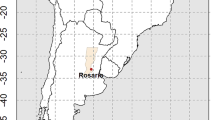Abstract
Changes in climate have significant impacts on built environment. Many of the potential effects of climate change on the building sector are not well known. Previous studies have used a small number of climate projection models and scenarios, with the majority only using one or two models with multiple scenarios. This study identified and analyzed twenty-three climate models with one or more scenario for each model for total of fifty-six model scenarios. Future hourly weather data between 2011 and 2099 was generated with the morphing algorithm for seven climate zones in the US. Using cooling degree day (CDD) and heating degree day (HDD) as energy impact indicators, the study revealed that different climate models (even within the same RCP scenario) yield largely different results for building energy implications. To simplify application, four reference climate models were selected to represent the full range of the fifty-six model outputs, whose accuracy was validated using historical data. The study explored the impacts of climate changes on energy use of five typical US building types in Ann Arbor, MI, as a demonstration, which presented a general trend of site energy decrease and source energy increase for this location. The research further examined the influences of humidity and found that dry bulb temperature dominates the changes in building energy consumption and relative humidity only has a relatively larger impact on extreme cases in cooling dominated climates.
Similar content being viewed by others
References
Aijazi, A, Brager, G (2018). Understanding climate change impacts on building energy. ASHRAE Journal, 60(10): 24–32.
Amato, AD, Ruth, M, Kirshen, P, Horwitz, J (2005). Regional energy demand responses to climate change: methodology and application to the commonwealth of Massachusetts. Climatic Change, 71: 175–201.
Angeles, ME, González, JE, Ramírez, N (2018). Impacts of climate change on building energy demands in the intra-Americas region. Theoretical and Applied Climatology, 133: 59–72.
ANSI/ASHRAE/IES (2010). ANSI/ASHRAE/IES 90.1-2010, Energy Standard for Buildings Except Low Rise Residential Buildings. Atlanta: American Society of Heating, Refrigerating and Air- Conditioning Engineers.
Belcher, S, Hacker, J, Powell, D (2005). Constructing design weather data for future climates. Building Services Engineering Research and Technology, 26: 49–61.
Cao, M, Li, M, Wang, M, Xiong, M, Meng, F (2017). Effects of climate change on outdoor meteorological parameters for building energysaving design in the different climate zones of China. Energy and Buildings, 146: 65–72.
Cellura, M, Guarino, F, Longo, S, Tumminia, G (2018). Climate change and the building sector: Modelling and energy implications to an office building in southern Europe. Energy for Sustainable Development, 45: 46–65.
Chan, ALS (2011). Developing future hourly weather files for studying the impact of climate change on building energy performance in Hong Kong. Energy and Buildings, 43: 2860–2868.
Cooper, I (2010). Adapting to the impact of climate change on buildings, neighborhoods and cities. Eclipse Research Consultants. Available at http://www.eclipseresearch.co.uk/download/sustainability_climate_change/Adapting%20to%20the%20impact%20of%20climate.pdf.
Department of Ecology (2012). Preparing for a Changing Climate— Washington State Integrated Climate Change Response Strategy. Washington State Department of Ecology. April 2012, Publication No. 12-01-004. Available at https://fortress.wa.gov/ecy/publications/documents/1201004.pdf.
Huang, YJ, Miller, N, Schlegel, N (2009). Effects of global climate changes on building energy consumption and its implications on building energy codes and policy in California: PIER Final Project Report, California Energy Commission, Berkeley, CA, USA.
Huang, J, Gurney, KR (2016). The variation of climate change impact on building energy consumption to building type and spatiotemporal scale. Energy, 111: 137–153.
Huovila, P (2017). Buildings and Climate Change: Status, Challenges, and Opportunities. Paris, France: United Nations Environment Programme, Sustainable Consumption and Production Branch.
IPCC (2007). IPCC Fourth Assessment Report (AR4). Available at https://www.ipcc.ch/report/ar4/
IPCC (2014). IPCC Fifth Assessment Report (AR5). Available at https://www.ipcc.ch/report/ar5/
Jentsch MF, Bahaj AS, James PAB (2008).
Jensch, MF, AbuBakr, SB, Patrick, ABJ (2008). Climate change future proofing of buildings—Generation and assessment of building simulation weather files. Energy and Buildings, 40: 2148–2168.
Levine, M, Urge-Vorsatz, D, Blok, K, et al. (2007). Residential and commercial buildings. In: Climate Change 2007: Mitigation, Cambridge, UK.
Olonscheck, M, Holsten, A, Kropp, JP (2011). Heating and cooling energy demand and related emissions of the German residential building stock under climate change. Energy Policy, 39: 4795–4806.
Oregon Climate Change Research Institute (2010). Oregon Climate Assessment Report. Dello KD, Mote PW (eds), Oregon State University, Corvallis, OR, USA.
Pérez-Andreu, V, Aparicio-Fernández, C, Martínez-Ibernón, A, Vivancos, JL (2018). Impact of climate change on heating and cooling energy demand in a residential building in a Mediterranean climate. Energy, 165: 63–74.
Rosenthal, DH, Gruenspecht, HK, Moran, EA (1995). Effects of global warming on energy use for space heating and cooling in the United States. The Energy Journal, 16: 77–96.
Shen, P (2017). Impacts of climate change on US building energy use by using downscaled hourly future weather data. Energy and Buildings, 134: 61–70.
US Department of Energy (2011). Buildings Energy Data Book. Department of Energy, Washington DC. Available at https://openei.org/ doe-opendata/dataset/buildings-energy-data-book.
Wang, H, Chen, Q (2014). Impact of climate change heating and cooling energy use in buildings in the United States. Energy and Buildings, 82: 428–436.
Wang, X, Chen, D, Ren, Z (2010). Assessment of climate change impact on residential building heating and cooling energy requirement in Australia. Building and Environment, 45: 1663–1682.
Zhu, M, Pan, Y, Huang, Z, Xu, P, Sha, H (2013). Future hourly weather files generation for studying the impact of climate change on building energy demand in China. In: Proceedings of the 13th International IBPSA Building Simulation Conference, Chambéry, France.
Author information
Authors and Affiliations
Corresponding author
Electronic supplementary material
Rights and permissions
About this article
Cite this article
Zhai, Z.J., Helman, J.M. Climate change: Projections and implications to building energy use. Build. Simul. 12, 585–596 (2019). https://doi.org/10.1007/s12273-019-0509-5
Received:
Revised:
Accepted:
Published:
Issue Date:
DOI: https://doi.org/10.1007/s12273-019-0509-5




